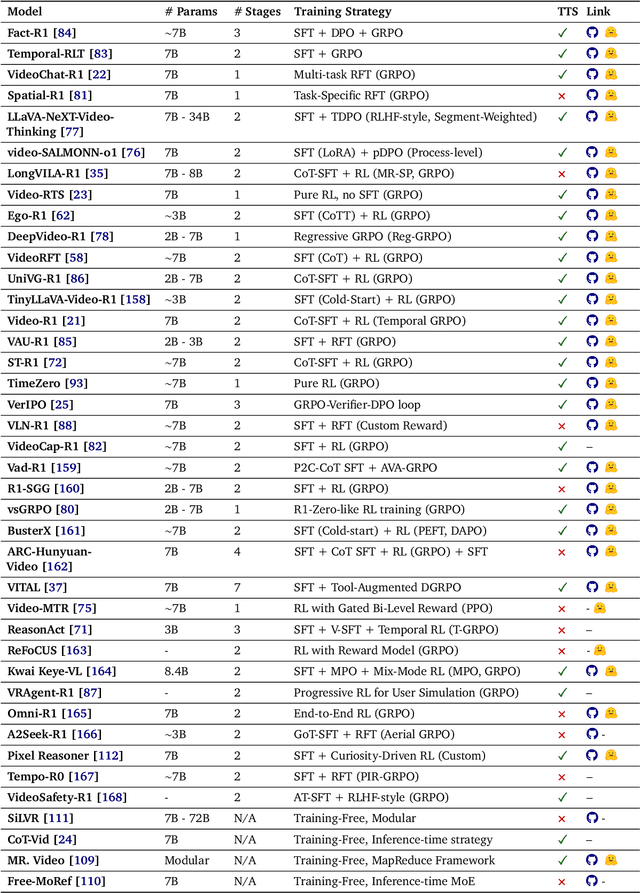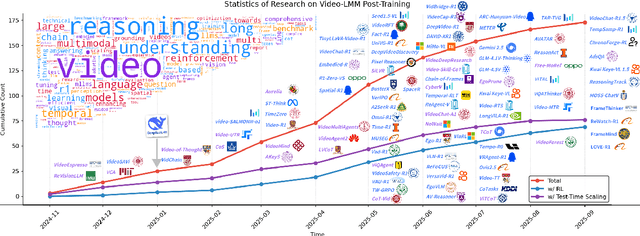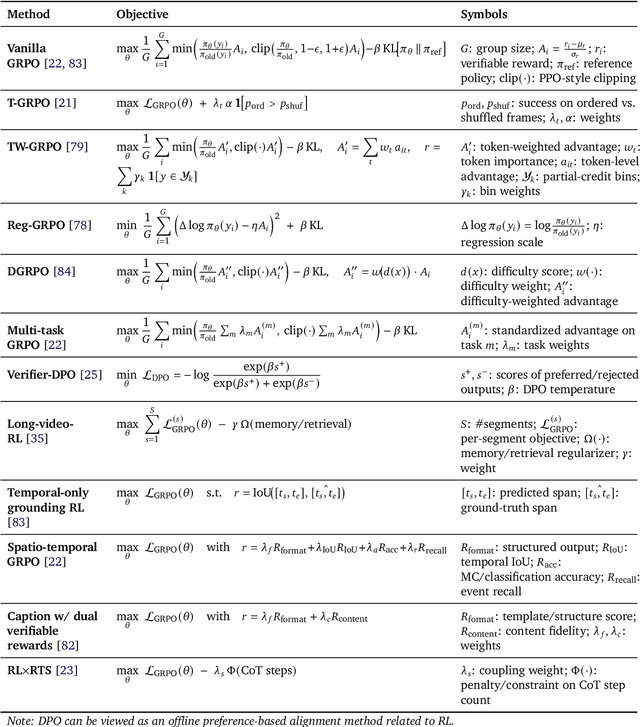Chao Huang
Every Step Evolves: Scaling Reinforcement Learning for Trillion-Scale Thinking Model
Oct 21, 2025Abstract:We present Ring-1T, the first open-source, state-of-the-art thinking model with a trillion-scale parameter. It features 1 trillion total parameters and activates approximately 50 billion per token. Training such models at a trillion-parameter scale introduces unprecedented challenges, including train-inference misalignment, inefficiencies in rollout processing, and bottlenecks in the RL system. To address these, we pioneer three interconnected innovations: (1) IcePop stabilizes RL training via token-level discrepancy masking and clipping, resolving instability from training-inference mismatches; (2) C3PO++ improves resource utilization for long rollouts under a token budget by dynamically partitioning them, thereby obtaining high time efficiency; and (3) ASystem, a high-performance RL framework designed to overcome the systemic bottlenecks that impede trillion-parameter model training. Ring-1T delivers breakthrough results across critical benchmarks: 93.4 on AIME-2025, 86.72 on HMMT-2025, 2088 on CodeForces, and 55.94 on ARC-AGI-v1. Notably, it attains a silver medal-level result on the IMO-2025, underscoring its exceptional reasoning capabilities. By releasing the complete 1T parameter MoE model to the community, we provide the research community with direct access to cutting-edge reasoning capabilities. This contribution marks a significant milestone in democratizing large-scale reasoning intelligence and establishes a new baseline for open-source model performance.
RAG-Anything: All-in-One RAG Framework
Oct 14, 2025Abstract:Retrieval-Augmented Generation (RAG) has emerged as a fundamental paradigm for expanding Large Language Models beyond their static training limitations. However, a critical misalignment exists between current RAG capabilities and real-world information environments. Modern knowledge repositories are inherently multimodal, containing rich combinations of textual content, visual elements, structured tables, and mathematical expressions. Yet existing RAG frameworks are limited to textual content, creating fundamental gaps when processing multimodal documents. We present RAG-Anything, a unified framework that enables comprehensive knowledge retrieval across all modalities. Our approach reconceptualizes multimodal content as interconnected knowledge entities rather than isolated data types. The framework introduces dual-graph construction to capture both cross-modal relationships and textual semantics within a unified representation. We develop cross-modal hybrid retrieval that combines structural knowledge navigation with semantic matching. This enables effective reasoning over heterogeneous content where relevant evidence spans multiple modalities. RAG-Anything demonstrates superior performance on challenging multimodal benchmarks, achieving significant improvements over state-of-the-art methods. Performance gains become particularly pronounced on long documents where traditional approaches fail. Our framework establishes a new paradigm for multimodal knowledge access, eliminating the architectural fragmentation that constrains current systems. Our framework is open-sourced at: https://github.com/HKUDS/RAG-Anything.
LightReasoner: Can Small Language Models Teach Large Language Models Reasoning?
Oct 09, 2025Abstract:Large language models (LLMs) have demonstrated remarkable progress in reasoning, often through supervised fine-tuning (SFT). However, SFT is resource-intensive, relying on large curated datasets, rejection-sampled demonstrations, and uniform optimization across all tokens, even though only a fraction carry meaningful learning value. In this work, we explore a counterintuitive idea: can smaller language models (SLMs) teach larger language models (LLMs) by revealing high-value reasoning moments that reflect the latter's unique strength? We propose LightReasoner, a novel framework that leverages the behavioral divergence between a stronger expert model (LLM) and a weaker amateur model (SLM). LightReasoner operates in two stages: (1) a sampling stage that pinpoints critical reasoning moments and constructs supervision examples capturing the expert's advantage through expert-amateur contrast, and (2) a fine-tuning stage that aligns the expert model with these distilled examples, amplifying its reasoning strengths. Across seven mathematical benchmarks, LightReasoner improves accuracy by up to 28.1%, while reducing time consumption by 90%, sampled problems by 80%, and tuned token usage by 99%, all without relying on ground-truth labels. By turning weaker SLMs into effective teaching signals, LightReasoner offers a scalable and resource-efficient approach for advancing LLM reasoning. Code is available at: https://github.com/HKUDS/LightReasoner
Understanding DeepResearch via Reports
Oct 09, 2025Abstract:DeepResearch agents represent a transformative AI paradigm, conducting expert-level research through sophisticated reasoning and multi-tool integration. However, evaluating these systems remains critically challenging due to open-ended research scenarios and existing benchmarks that focus on isolated capabilities rather than holistic performance. Unlike traditional LLM tasks, DeepResearch systems must synthesize diverse sources, generate insights, and present coherent findings, which are capabilities that resist simple verification. To address this gap, we introduce DeepResearch-ReportEval, a comprehensive framework designed to assess DeepResearch systems through their most representative outputs: research reports. Our approach systematically measures three dimensions: quality, redundancy, and factuality, using an innovative LLM-as-a-Judge methodology achieving strong expert concordance. We contribute a standardized benchmark of 100 curated queries spanning 12 real-world categories, enabling systematic capability comparison. Our evaluation of four leading commercial systems reveals distinct design philosophies and performance trade-offs, establishing foundational insights as DeepResearch evolves from information assistants toward intelligent research partners. Source code and data are available at: https://github.com/HKUDS/DeepResearch-Eval.
Video-LMM Post-Training: A Deep Dive into Video Reasoning with Large Multimodal Models
Oct 06, 2025



Abstract:Video understanding represents the most challenging frontier in computer vision, requiring models to reason about complex spatiotemporal relationships, long-term dependencies, and multimodal evidence. The recent emergence of Video-Large Multimodal Models (Video-LMMs), which integrate visual encoders with powerful decoder-based language models, has demonstrated remarkable capabilities in video understanding tasks. However, the critical phase that transforms these models from basic perception systems into sophisticated reasoning engines, post-training, remains fragmented across the literature. This survey provides the first comprehensive examination of post-training methodologies for Video-LMMs, encompassing three fundamental pillars: supervised fine-tuning (SFT) with chain-of-thought, reinforcement learning (RL) from verifiable objectives, and test-time scaling (TTS) through enhanced inference computation. We present a structured taxonomy that clarifies the roles, interconnections, and video-specific adaptations of these techniques, addressing unique challenges such as temporal localization, spatiotemporal grounding, long video efficiency, and multimodal evidence integration. Through systematic analysis of representative methods, we synthesize key design principles, insights, and evaluation protocols while identifying critical open challenges in reward design, scalability, and cost-performance optimization. We further curate essential benchmarks, datasets, and metrics to facilitate rigorous assessment of post-training effectiveness. This survey aims to provide researchers and practitioners with a unified framework for advancing Video-LMM capabilities. Additional resources and updates are maintained at: https://github.com/yunlong10/Awesome-Video-LMM-Post-Training
High-Quality Sound Separation Across Diverse Categories via Visually-Guided Generative Modeling
Sep 26, 2025Abstract:We propose DAVIS, a Diffusion-based Audio-VIsual Separation framework that solves the audio-visual sound source separation task through generative learning. Existing methods typically frame sound separation as a mask-based regression problem, achieving significant progress. However, they face limitations in capturing the complex data distribution required for high-quality separation of sounds from diverse categories. In contrast, DAVIS circumvents these issues by leveraging potent generative modeling paradigms, specifically Denoising Diffusion Probabilistic Models (DDPM) and the more recent Flow Matching (FM), integrated within a specialized Separation U-Net architecture. Our framework operates by synthesizing the desired separated sound spectrograms directly from a noise distribution, conditioned concurrently on the mixed audio input and associated visual information. The inherent nature of its generative objective makes DAVIS particularly adept at producing high-quality sound separations for diverse sound categories. We present comparative evaluations of DAVIS, encompassing both its DDPM and Flow Matching variants, against leading methods on the standard AVE and MUSIC datasets. The results affirm that both variants surpass existing approaches in separation quality, highlighting the efficacy of our generative framework for tackling the audio-visual source separation task.
Boosting Data Utilization for Multilingual Dense Retrieval
Sep 11, 2025Abstract:Multilingual dense retrieval aims to retrieve relevant documents across different languages based on a unified retriever model. The challenge lies in aligning representations of different languages in a shared vector space. The common practice is to fine-tune the dense retriever via contrastive learning, whose effectiveness highly relies on the quality of the negative sample and the efficacy of mini-batch data. Different from the existing studies that focus on developing sophisticated model architecture, we propose a method to boost data utilization for multilingual dense retrieval by obtaining high-quality hard negative samples and effective mini-batch data. The extensive experimental results on a multilingual retrieval benchmark, MIRACL, with 16 languages demonstrate the effectiveness of our method by outperforming several existing strong baselines.
FlowSpec: Continuous Pipelined Speculative Decoding for Efficient Distributed LLM Inference
Jul 03, 2025Abstract:Distributed inference serves as a promising approach to enabling the inference of large language models (LLMs) at the network edge. It distributes the inference process to multiple devices to ensure that the LLMs can fit into the device memory. Recent pipeline-based approaches have the potential to parallelize communication and computation, which helps reduce inference latency. However, the benefit diminishes when the inference request at the network edge is sparse, where pipeline is typically at low utilization. To enable efficient distributed LLM inference at the edge, we propose \textbf{FlowSpec}, a pipeline-parallel tree-based speculative decoding framework. FlowSpec incorporates three key mechanisms to improve decoding efficiency: 1) score-based step-wise verification prioritizes more important draft tokens to bring earlier accpeted tokens; 2) efficient draft management to prune invalid tokens while maintaining correct causal relationship during verification; 3) dynamic draft expansion strategies to supply high-quality speculative inputs. These techniques work in concert to enhance both pipeline utilization and speculative efficiency. We evaluate FlowSpec on a real-world testbed with other baselines. Experimental results demonstrate that our proposed framework significantly improves inference speed across diverse models and configurations, achieving speedup ratios 1.36$\times$-1.77$\times$ compared to baselines. Our code is publicly available at \href{https://github.com/Leosang-lx/FlowSpec#}{https://github.com/Leosang-lx/FlowSpec\#}
RecGPT: A Foundation Model for Sequential Recommendation
Jun 06, 2025Abstract:This work addresses a fundamental barrier in recommender systems: the inability to generalize across domains without extensive retraining. Traditional ID-based approaches fail entirely in cold-start and cross-domain scenarios where new users or items lack sufficient interaction history. Inspired by foundation models' cross-domain success, we develop a foundation model for sequential recommendation that achieves genuine zero-shot generalization capabilities. Our approach fundamentally departs from existing ID-based methods by deriving item representations exclusively from textual features. This enables immediate embedding of any new item without model retraining. We introduce unified item tokenization with Finite Scalar Quantization that transforms heterogeneous textual descriptions into standardized discrete tokens. This eliminates domain barriers that plague existing systems. Additionally, the framework features hybrid bidirectional-causal attention that captures both intra-item token coherence and inter-item sequential dependencies. An efficient catalog-aware beam search decoder enables real-time token-to-item mapping. Unlike conventional approaches confined to their training domains, RecGPT naturally bridges diverse recommendation contexts through its domain-invariant tokenization mechanism. Comprehensive evaluations across six datasets and industrial scenarios demonstrate consistent performance advantages.
Pre-training for Recommendation Unlearning
May 29, 2025Abstract:Modern recommender systems powered by Graph Neural Networks (GNNs) excel at modeling complex user-item interactions, yet increasingly face scenarios requiring selective forgetting of training data. Beyond user requests to remove specific interactions due to privacy concerns or preference changes, regulatory frameworks mandate recommender systems' ability to eliminate the influence of certain user data from models. This recommendation unlearning challenge presents unique difficulties as removing connections within interaction graphs creates ripple effects throughout the model, potentially impacting recommendations for numerous users. Traditional approaches suffer from significant drawbacks: fragmentation methods damage graph structure and diminish performance, while influence function techniques make assumptions that may not hold in complex GNNs, particularly with self-supervised or random architectures. To address these limitations, we propose a novel model-agnostic pre-training paradigm UnlearnRec that prepares systems for efficient unlearning operations. Our Influence Encoder takes unlearning requests together with existing model parameters and directly produces updated parameters of unlearned model with little fine-tuning, avoiding complete retraining while preserving model performance characteristics. Extensive evaluation on public benchmarks demonstrates that our method delivers exceptional unlearning effectiveness while providing more than 10x speedup compared to retraining approaches. We release our method implementation at: https://github.com/HKUDS/UnlearnRec.
 Add to Chrome
Add to Chrome Add to Firefox
Add to Firefox Add to Edge
Add to Edge